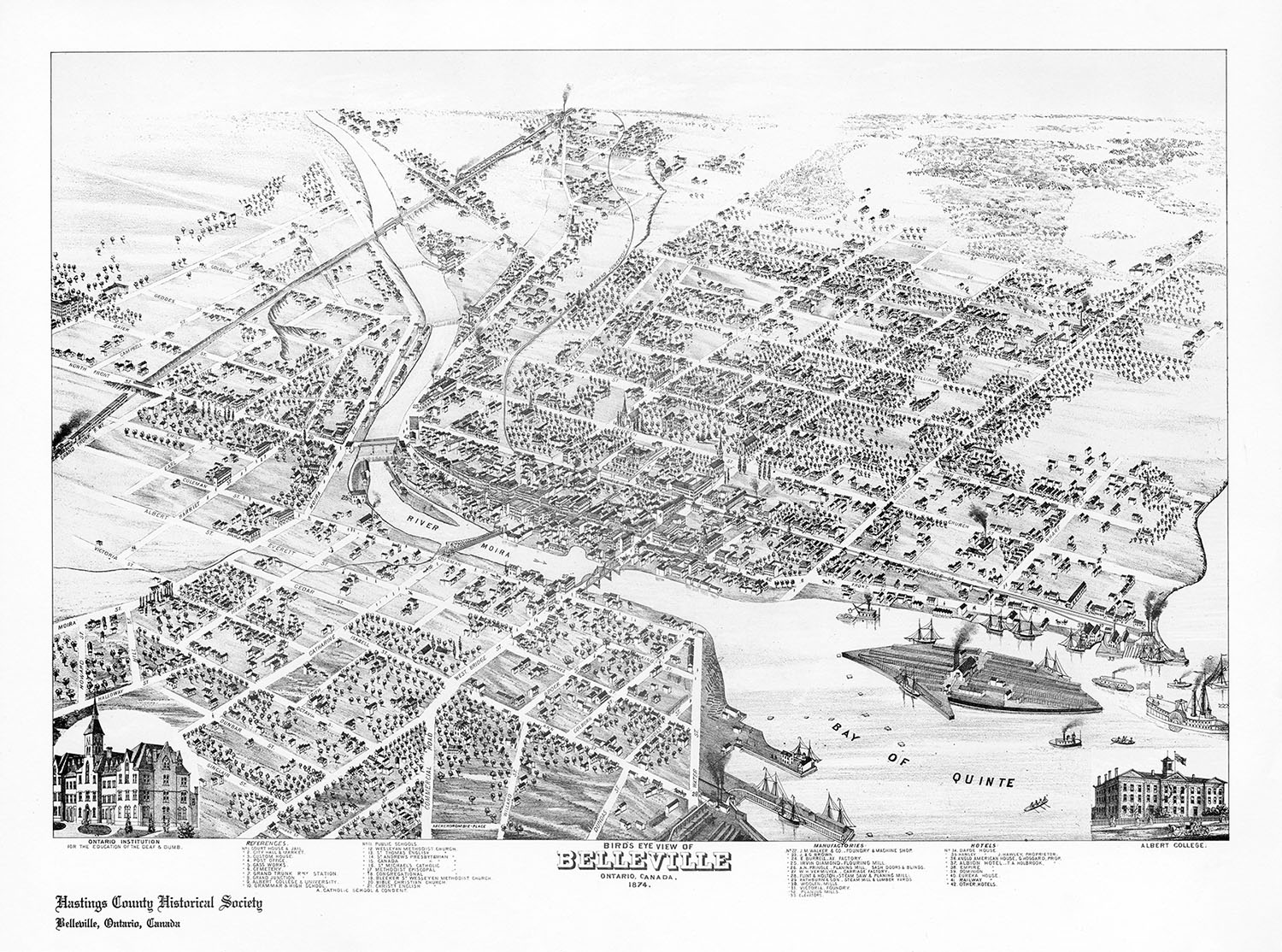With its strategic location at the meeting of the Bay of Quinte and the Moira River, Belleville has long been an attractive and economically active destination, attracting people looking for a better life.
The site of the present-day city was first occupied by various Indigenous peoples, drawn by its sheltered waters, easy access to Lake Ontario and abundance of fishing, such as Anishinaabe (Mississaugas) people who had a village here known as Asukhknosk.
Loyalist Settlement
The first large arrival of settlers came in 1789, when some fifty United Empire Loyalists arrived. The most notable was Captain John Walden Meyers who built a dam on the Moira River, erected a sawmill, gristmill and distillery and operated a trading post and brick kiln. The gristmill drew settlers from Napanee to Port Hope and the community soon became known as Meyers' Creek. He is credited with building the first brick house in Upper Canada in 1794.
A Thriving Centre for Lumber, Railroads & Industry
A strong demand for timber in England in the 1800s made Belleville a bustling lumber town. Rich forests nearby were accessible by the Moira River and French Canadian loggers were a familiar sight. The logs were cut into timber at several local mills and taken down the St. Lawrence to Quebec. With export trade in lumber and flour, Belleville's harbour was alive with vessels of every description. Belleville was known as the most prosperous town in Upper Canada.
A visit in 1816 by Lieutenant-Governor Sir Francis Gore inspired the residents to change the name of their settlement to Belleville in honour his wife Lady Arabella.
The arrival of the Grand Trunk Railway in 1856 gave Belleville a link with Montreal and Toronto. For many years the railway was Belleville's largest employer.
While the lumber trade declined towards the end of the 1900s, industries were expanding and handcrafted items gave way to factory made goods. Foundries and manufacturers of furniture, wagons, carriages, candles and soap abounded.
Gateway to the Golden North
Discovery of gold near Madoc in 1866 earned Belleville the name “The Gateway to the Golden North”, as miners stopped for supplies on their way north of the city.
World-class Cheddar & Spirits
The Corby family played an important role in the development of Belleville and area, beginning with Henry Corby's arrival from England in 1832. After running a bakery and serving in the Rebellion of 1837, he bought a steamer named the Queen which operated as a grain merchant along the shores of Lake Ontario. In 1857, Corby built a dam and established a grist-mill on the bank of the Moira River. One of the 'sidelines' of running a grist mill was the distillation of liquor, which most farmers at the time did with inferior grain. In 1859, Corby built a distillery, one that would be in operation for 130 years. In 1867, the year of Canada's Confederation, Corby was elected as the Mayor of Belleville's and later served as a Member of Provincial Parliament.
Corby's businesses were only part of Belleville flourishing agricultural activities. In the late 1880s and early 1900s, the region was well known for its fruit and vegetable growing and had many canning factories, including the Belleville Canning Factory, which was advertised to be the largest cannery in Canada. In addition, dozens of cheese factories in the area helped make the City and Hastings County renowned for its world-class cheddar.
5 Ways to Experience Belleville History
- Walk Through East Hill – Many of the houses those Loyalists and their descendants built are located in Belleville's East Hill, a short walk from downtown. Make sure to stop by Corby Rose Garden. The garden features display beds of 2,000 roses, perennial and annual flowers and a lovely fountain.
- Soak up the History at Signal Brewery – The Corby Distillery property was left abandoned for almost 25 years until Signal Brewing Co. began restoring the old buildings, and opened a craft beer, restaurant and event venue. Last fall Signal renovated the former River Inn, a property located immediately south of the brewery, which is now home to Henry's, in honour of Henry Corby himself. The brewery is a must stop attraction for beer made with love, thought and passion and food perfect for sharing!
- Cycle along the River – Ride along this historic river on the Parrott Riverfront Trail, starting from Dundas St. and heading north to Memorial Park. Or keep going by crossing on the Trail's bridge and continue north on the west bank through Riverside Park. Request a copy of the Trail Map at or visit Belleville's Visitors Centre on the 3rd floor of City Hall.
- Tour Glanmore – This Second Empire gem and National Historic Site, complete with Victorian treasures and the world-renown Couldery Collection is a must-see destination.
- Browse the Collections – The Community Archives of Belleville and Hastings County preserves history through the records of local governments, individuals, families, businesses and organizations. Check out their wonderful photo collections and more in person or online.


